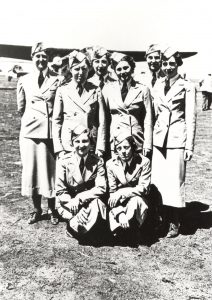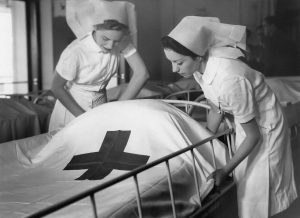The Second in a series of Blogs about the 31 Medical Air Evacuation
Transport Squadrons activated during WW2
to provide inflight nursing care to sick and wounded soldiers,
tended by Army flight nurses and enlisted technicians.
The focus is on the flight nurses.
The Army Air Forces Flight Nurse Program
When pilot Lauretta Schimmoler founded the Aerial Nurse Corps of America in the 1930s, she intended that her organization would become the air unit of the American Red Cross (ARC), which provided a reserve pool of applicants from which the military drew its nurses. When both the ARC and the American Nurses Association dismissed her plan, in large part because she was a pilot, not a nurse, and nursing leaders wanted to maintain control of their profession, Schimmoler pitched her plan to military leaders, starting at the top. That her letter to General Henry H. (Hap) Arnold, Acting Chief of the Air Corps, had caught his attention is evident in his October 1937 correspondence to Schimmoler:
Just a note to express my regret that I didn’t get a chance to see you while out on the Coast and talk over the program of the Aerial Nurse Corps of America. I hope, however, to discuss the subject with you in detail. I believe there is a place in the scheme of things for such an organization, but just what that place is I will be unable to definitely decide until I know more of the details. 1
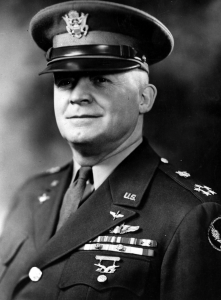 General Henry H. Arnold (USAF Photo)
General Henry H. Arnold (USAF Photo)
Once he had learned more details, however, Arnold’s reply, drafted by Colonel Malcolm C. Grow, Chief of the Medical Section, with input from Major Julia O. Flikke, Army Nurse Corps Superintendent, was not encouraging:
I do believe, however, that inasmuch as the American Red Cross has been designated by law (Army Regulation 850–75) that this organization is in effect in time of emergency an auxiliary aid to the Medical Department of the Army, it would be advisable that you should work in conjunction with that organization. 2
Arnold enclosed a copy of Army Regulation 850–75 “Employment of American National Red Cross” to acquaint Schimmoler with the provisions of this regulation. Not appearing in Arnold’s letter was Flikke’s belief that “Miss Schimmoler’s plan is very complete and would be of great value if it could be used but it would conflict with the present set up if carried on independently.” 3
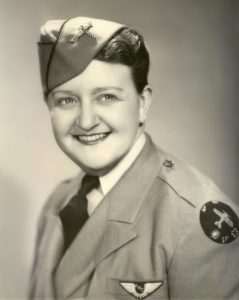 Lauretta M. Schimmoler, Commander,
Lauretta M. Schimmoler, Commander,
Aerial Nurse Corps of America (AMEDD)
Schimmoler next appealed in April 1938 to Major Flikke to give the patriotic young ANCOA nurses a definite place ‘in the scheme of national defense in the event of a major national emergency’; Flicke’s reply reinforced General Arnold’s stance:
As you know, the reserve nurses for the Federal services have always been supplied by the American Red Cross – a practice which we hope will always obtain. Perfect harmony and co-operation exist between the Army, Navy and Red Cross, and efficient service has always been rendered. 4
In August 1942, with approximately 400 ANCOA nurses on hospital duty with the armed forces, a clearly frustrated Schimmoler tried once more to elicit military support for assigning them flight nurse duties. She turned to Brigadier General David N.W. Grant, Air Surgeon for the Army Air Forces (AAF), with her plea:
Frankly, General, I have almost begun to think that I am another Billy Mitchell. I have not, however, given up hope that some how some way that your department will embark upon the creation of a school for nurses for air ambulance duty and that we [ANCOA] might be accorded the consideration of doing our part in the operations of this school. I feel this department should be separate apart from the regular Army Nurse Corps and be attached as a special unit of the Air Forces. …
There isn’t a question in my mind, with the interest there exists in this field, that if we had the support and authority needed, that we could create an Air ambulance unit that you could well be proud of. 5
“The question of aerial evacuation with the armed forces is now in the formative stage,” Grant replied.
Nurses will be assigned from the Army Nurse Corps for this work. Many nurses who have had prior experience with the airlines are available for this purpose. Evacuation, as contemplated, is of the mass type during actual combat.
There are many vacancies in the Army Nurse Corps, which members of your association can join. Nurses are not being recruited specifically for aerial duty, but are being earmarked for this duty when the need arises. …
I hope this answers your question. 6
It did, but for Schimmoler, it was the wrong answer.
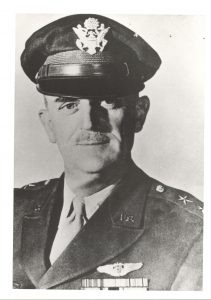 David N.W. Grant, Air Surgeon,
David N.W. Grant, Air Surgeon,
Army Air Forces (USAF Photo)
The novel plan for an air evacuation system incorporated the evacuation of casualties into the duties of the Troop Carrier Command whose tactical mission was to fly men and equipment into combat areas and of the Air Transport Command (ATC) responsible for strategic flights between overseas locations and the US. These transport planes, when outfitted with litter installations, could be converted into air ambulances for the return trip once troops and cargo were offloaded, putting to humanitarian use planes that would have returned to their bases empty. Colonel Wood S. Woolford, the first ATC Surgeon, is credited with the idea of employing women in the Army Nurse Corps as flight nurses on air evacuation missions. 7 At the time, only women served as Army nurses. Although the Army had male nurses, they were assigned duty as enlisted medical technicians. 8
Events happened quickly in the development of the air evacuation system. In September 1942 the 38th Medical Air Ambulance Squadron, a “paperwork” organization with 1 officer and a few enlisted men, activated at Fort Benning, GA the previous May, was transferred to Bowman Field, KY, chosen for its proximity to the First Troop Carrier Command headquarters in Indianapolis just over 100 miles north and because of facilities in place as the former site of the Medical Officer Training School. 9
Upon arrival, the squadron, now numbering 140 men, was assigned to the First Troop Carrier Command, which had responsibility for organizing and training air evacuation groups, and was attached to the base hospital. The 38th Medical Air Ambulance Squadron, now part of the Army Air Forces, was re-designated the 507th Air Evacuation Squadron, Heavy, 3 days later and served as the nucleus for the air evacuation system. Flight nurses were among the 507th personnel. The 349th Air Evacuation Group activated at Bowman Field in October 1942 incorporated the 507th Air Evacuation Squadron, Heavy, and 3 new units – the 620th and 621st Air Evacuation Squadrons, Heavy, and the 622nd Air Evacuation Squadron, Light, all activated in November. 10 “Heavy” squadrons were those that would fly multi-engine cargo transport planes. The plan for “Light” squadrons with smaller single-engine airplanes capable of carrying no more than three patients was abandoned when the planes went to Navy rather than the AAF. 11 The Medical Air Evacuation Transport Squadron (MAETS), renamed Medical Air Evacuation Squadron (MAES) on 19 July 1944, included a headquarters section with flight surgeon commander, chief nurse and support staff, and out in the field 4 evacuation flights of 6 flight nurses and 6 enlisted surgical technicians, each flight commanded by a flight surgeon. Flight teams consisting of 1 flight nurse and 1 surgical technician were to be placed aboard transport planes as needed, and when personnel were short or when casualty loads exceeded available teams, the flight nurse and the surgical technician could fly in separate planes. 12
As the war progressed, the need for an air evacuation system overseas became more urgent. At Bowman Field in December 1942, the 507th, 620th, and 621st Aeromedical Evacuation Squadrons, Heavy, were re-designated the 801st, 802nd, and 803rd MAETS. 13 The 801 MAETS and 802 MAETS, which included flight nurses among their members, were hastily trained in the essentials of air evacuation without benefit of a formal course – an “admittedly meager and inadequate” preparation for the work ahead. 14 On Christmas Day 1942 the first of these squadrons, the 802 MAETS, departed Bowman Field for North Africa to provide air evacuation support for the Tunisian Campaign. 15 Just over 3 weeks later the 801 MAETS left Bowman Field for the South Pacific where American troops were still engaged in the battle of Guadalcanal. 16
By the end of 1944, 31 MAES had been activated for air evacuation duty throughout the world in every theater of operations, and the nurses aboard those missions had completed a formal course of flight nurse training at the School of Air Evacuation at Bowman Field, which graduated its first class on 18 February 1943.
For more about the ANCOA, see Beyond the Call of Duty: Army Flight Nursing in World War II, Chapter 1. For more about Lauretta Schimmoler and ANCOA, see the Blogs posted in 8 parts, beginning 1 Oct 2018.
Notes
- H.H. [Henry H.] Arnold, letter to Lauretta M. Schimmoler, 27 Sep 1937.
- Henry H. Arnold, letter to Lauretta M. Schimmoler, 20 Oct 1937.
- Julia O. Flikke, memo to Malcolm C. Grow, 11 Oct 1937. Grow’s full title was Chief Flight Surgeon in the Office of the Chief of the Army Air Corps.
- Julia O. Flikke, letter to Lauretta M. Schimmoler, 29 Apr 1938.
- Lauretta M. Schimmoler, letter to David N.W. Grant, 24 Jul 1942.
- David N.W. Grant, letter to Lauretta M. Schimmoler, 3 Aug 1942.
- Wood S. Woolford, letter to Victor A. Byrne, 17 Jul 1942; “History of the School of Air Evacuation”, 1 Aug 1943, 2–4; “History of the School of Air Evacuation”, in “School of Air Evacuation”, Army Air Base, Bowman Field, KY, 9 Dec 1940 – Apr 1944; Jan 1944 – Jun 1945, 1–3; Robert F. Futrell, Development of Aeromedical Evacuation in the USAF, 1909–1960, Historical Studies No. 23 (Maxwell AFB, AL: USAF Historical Division, Research Studies Institute, Air University; Manhattan, KS: Military Affairs / Aerospace Historian, 1960), 73–74.
- “Men Nurses and the Armed Services”, American Journal of Nursing 43 (Dec 1943): 1066–69.
- Mae M. Link and Hubert A. Coleman, Medical Support of the Army Air Forces in World War II (Washington, DC: US Government Printing Office, 1955), 367.
- “Medical History, I Troop Carrier Command”, 30 Apr 1942 – 31 Dec 1944, 50–52.
- Ibid.; “History of the School of Air Evacuation”, 1 Aug 1943, 2–4; Futrell, Aeromedical Evacuation, 73–74.
- Frederick R. Guilford and Burton J. Soboroff, “Air Evacuation: An Historical Review”, Journal of Aviation Medicine 18 (Dec 1947): 609; Futrell, Aeromedical Evacuation, 78–79; “Medical Air Evacuation Transport Squadron”, Table of Organization No. 447, War Department, Washington, DC, 15 Feb 1943.
- “Post Diary”, Air Base Headquarters, Bowman Field, Louisville, KY, Dec 1940 – Aug 1945, 49.
- Futrell, Aeromedical Evacuation, 80.
- “Medical History, 802nd Medical Air Evacuation Squadron”, 10 Dec 1942 – 30 Jun 1944, [1].
- “Post Diary”, Air Base Headquarters, Bowman Field, Louisville, KY, Dec 1940 – Aug 1945, 51.

